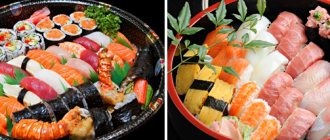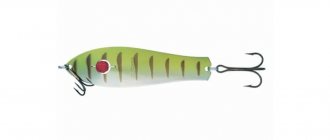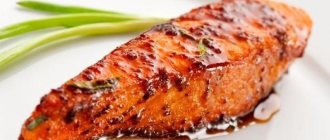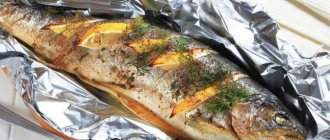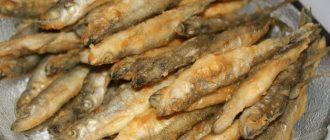Place number 4. Aji fish
The Japanese prefer to use aji fish to make oshizushi or sushi, where rice is mixed with vinegar and fish. In addition, fried fish is served hot.
“Some kind of reaction to a nut”: Regina Todorenko spent Valentine’s Day in the hospital
You can sow seedlings in February: but only at the end of the month (4 crops)
How names are chosen for royal children: principles are gradually changing
Japanese fish recipes
Fish dishes occupy a huge niche in the gastronomic world. Fish is used in the preparation of a large number of tasty and healthy dishes: first of all, stand-alone dishes, then soups and cutlets, appetizers, pastries, salads and even dumplings. Depending on whether the fish is oceanic, sea or freshwater, fish dishes differ in shades of taste and smell. You can cook it in different ways: fry in a frying pan, boil, bake in the oven, grill, salt or eat raw. The fish is minced and used as a filling in pies and casseroles. Asian cuisine is famous for its fish dishes, and especially fish salads, which often contain raw fish. Marinated in vinegar and spices, it becomes tender and pleasant to eat. In addition, such fish is easily digestible and is suitable for those who count calories. The ability to fry a sea creature with a crispy crust is considered a great culinary skill: it does not take much time to bring the fish to readiness, and high temperatures are required to form a crust, so only those who often experiment with types of cooking fish can achieve the ideal balance. You can prepare easily tasty carpaccio and timbale from fish, namely salmon, salmon and tuna, herring is the key ingredient in the most popular New Year's salad, and, for example, pollock in batter remains equally tasty both hot and already cooled.
In traditional Japanese cuisine, seasonality is important: each season produces its own products, the main task of the chef is to preserve their original properties. Fresh and grilled fish, pork in sweet and sour sauce, miso soup and, of course, rice are popular here. China has had a great influence on Japanese cuisine. From there came dishes such as ramen noodles and gyoza, to the recipes of which the Japanese managed to add their own twist. Today, Japanese dishes are extremely popular and in demand. Oyakodon (omelet with rice and chicken, unagi-yanagawa), soup with shiitake mushrooms and eel tempura or kare-raisu (Japanese curry) can be ordered at any restaurant or prepared at home using recipes on the eda.ru website. Kare-raisu, by the way, has an interesting history: a cheap but satisfying dish was widespread among British sailors, who brought it with them to Japan and introduced it to the locals, for whom the taste of curry was very unusual. Kare-rice fell in love with the Japanese, and its recipe has not undergone major changes over time. Drinks in the Land of the Rising Sun include tea, rice vodka, sake, and juice-based soft drinks. Japanese sweets are collectively known as wagashi. To prepare them, adzuki bean paste, agar-agar, tea and various herbs are used. Among them are dorayaki (sponge cake filled with anko), mochi (boiled white rice balls in syrup) and yokan (sweet bean paste).
Search for recipes by selecting a dish category, subcategory, cuisine or menu. And in additional filters you can search by the desired (or unnecessary) ingredient: just start writing its name and the site will select the appropriate one.
Fish dishes
Many recipes have been invented using meat, caviar, and liver. In some dishes, fins and skin are used. The fish is served to the table sequentially: the layers from the back are brought first, the layers from the peritoneum are brought last. The cook monitors the visitor's reaction, determining at what point the meal becomes dangerous.
The most famous dish is fugusashi. Consists of slices of raw fish arranged on a tray in the shape of an intricate picture. Before eating, the piece is dipped in a vinegar sauce with onions, daikon and pepper.
Fugu is stewed, boiled, fried, pickled. A popular stew is made with cabbage, mushrooms, bean curd and spinach. It is seasoned with citrus juice, pepper and daikon.
Prices for fugu dishes
The price for a meal varies from 40-100 dollars for a set of 5 dishes. Lunch includes raw, stewed, fried fish and soup. In expensive restaurants, a portion can cost up to $500.
First they serve fugu sashimi, then soup with rice ornaments, then fried fish.
Various dishes are prepared from fugu
How to serve sashimi?
Sashimi - sliced pieces of raw fish - is served before the main meal, be it lunch or dinner. Chopped vegetables, seaweed, avocado, lime, ginger and wasabi are taken as a garnish. The Japanese use red seaweed (nori), carrots, daikon (Japanese radish), and Japanese cabbage as a classic side dish.
An important nuance for the Japanese: there should be an odd number of slices (3, 5 or 7).
Ginger and wasabi, in addition to being an additional flavoring ingredient, are excellent antibacterial agents - they disinfect fish. Wasabi is usually dissolved in soy sauce and pieces of sashimi are dipped into this sauce. It is better to eat ginger between courses - it interrupts and renews the taste.
also serve a simple salad with sashimi , consisting of chopped cucumbers, tomatoes and radishes, and use lemon juice as a dressing.
It is customary to serve sashimi with dry white wine or sake (Japanese vodka), and if a non-alcoholic holiday is planned, then green tea without sugar and with lemon.
Sauces
All kinds of sauces are common in Japanese cooking: sweet, sour, sweet and sour, salty, hot, spicy. Such dressings complement vegetable, meat, and fish dishes.
Today, Japanese sauces have spread throughout the world and are already an integral part of the diet of residents of many countries. The most popular are:
- Soy sauce. This dressing is dark brown in color and has a salty taste. Served with almost all dishes. The second name for the sauce is “shoyu”. Due to its excellent taste and beneficial properties, soy sauce is considered the king among others like it in Japan.
- Teriyaki. This dressing is a mixture of rice wine (mirin), Japanese sake vodka, brown sugar and soy sauce. Like soy, teriyaki is dark brown in color. Its flavor notes are sweetish and salty. Fish, seafood and meat products are products that teriyaki sauce will perfectly complement. Chicken, pork, beef, baked or fried fish, squid and shrimp will sparkle with new colors when combined with aromatic dressing.
- Wasabi. It is considered part sauce and not just a condiment. It, like soy sauce, is always served with sushi, and also goes well with main courses of fish, seafood and battered vegetables. Outwardly it looks like a green thick mixture, but its taste is simply nuclear! It is the Japanese equivalent of horseradish. Fans of such additives will like the burning taste.
- Peanut sauce. It is a mixture of sesame seeds and soybeans whipped in a blender with a “marinade” - rice vinegar, sesame oil, soy sauce, sugar, wheat (or corn) flour. The story goes that the sauce was created specifically for Chuki salad, but nowadays it is served with both seafood and meat (often chicken and pork).
- Sweet and sour sauce. The best option for sweet and sour sauce is meat, both fatty and dietary.
- Yakitori. This sauce is considered ideal for serving with chicken dishes. Yakitori consists of ginger root and apples, which are crushed and boiled in a marinade - a mixture of rice wine, white wine and soy sauce. Thanks to the addition of rice starch, the dressing has a thick consistency.
- Unagi is a sauce for fish and seafood. Soy sauce combined with dry white and rice wine, Hondashi fish broth, and brown sugar gives a simply amazing result - a spicy dressing for eel.
Fish dishes, Japanese cuisine
Recipes for main courses → Fish dishes
Japanese
Marinated pike perch - a recipe for tender fish in an original marinade. An unusual combination of fish and cinnamon. =)) Delicious. =))
The combination of cream cheese, fresh cucumber and tender avocado is complemented by the bright taste of smoked eel and sesame seeds.
Teriyaki is a Japanese marinade sauce for pieces of fish, meat or seafood. The word teriyaki is also used to describe a dish prepared with this sauce.
Unusual rolls - not with cucumber, but from cucumber, which replaces nori seaweed. And no rice. But with avocado, salmon, shrimp and cream cheese.
A very tasty and filling dish! Rice pancakes are tender and very tasty! And fish combined with them is simply wonderful! I recommend it to everyone!
Hura maki rolls made with fresh salmon, avocado and crab meat.
A delicious restaurant-quality Japanese dish - sea bass with mint sauce on a bed of asparagus.
Rolls and sushi are finding more and more admirers. And for good reason. Tasty, nutritious, unusual, beautiful. And making rolls at home is not that difficult. There would be a desire.
Sushi burrito (burrito) with salmon, vegetables, cheese.
I used to always order rolls like this with pleasure in one of our Japanese establishments. And recently I decided to try making them myself. I’m not sure that the ingredients I used are the same ones they use in the restaurant, but the taste was similar. The rolls are prepared very quickly, so I recommend them to everyone!
How to make delicious rolls at home. We make delicious rolls at home. Rolls with cucumber, pieces of salmon, seasoned with sesame seeds. Delicious. A simple recipe for making homemade rolls.
Japanese style lunch - tender salmon, buckwheat noodles and tender green peas.
Congrio is a shrimp-eating fish with a pink skin tone reminiscent of shrimp, which is why it is also known as shrimp fish. Recipes for preparing congrio are varied; it is a fish with a very delicate taste, practically devoid of bones, except for the backbone.
The recipe for salmon in caviar sauce with cream is suitable for a festive family table, entertaining guests or a romantic dinner. The salmon fillet is fried, a caviar sauce for the salmon is prepared separately, and then the salmon is served with caviar sauce, garnished with tomatoes and herbs.
How to pickle smelt? The recipes differ mainly in the marinade; this recipe for pickled smelt is taken from Japanese cuisine.
A large fish from the salmon family is coho salmon. Coho salmon recipes are in great demand, since this fish is undoubtedly healthy, its meat is very tender and practically devoid of small bones. Here we will tell you how to cook coho salmon stewed with vegetables.
All rights to materials located on the website www.RussianFood.com are protected in accordance with current legislation. For any use of site materials, a hyperlink to www.RussianFood.com is required.
Traditional soups and main dishes
In the country's cuisine, there is practically no division of dishes into first and second, and all dishes are put on the table at the same time, and the process of eating can begin with any dish. Only one thing is important - initially try all the dishes, and then you can eat what stood out with its taste and liked it more than others. It is remarkable how the Japanese eat all foods: noodles, rolls, soups and other dishes are eaten with chopsticks.
The assortment of first courses is not very large, however, it is varied. Along with the usual soups with meat and seafood, Japanese cuisine also has unique dishes, the likes of which cannot be found in the world. For example, there is a dish called “Otya Dzuke”, which is a kind of soup: boiled rice is sprinkled with fried sesame seeds, pieces of seaweed, as well as cubes of meat, after which the whole composition is poured with freshly brewed green tea.
A unique soup called Tendon is a delicious combination of rice, vegetables and seafood in broth. The list of ingredients for the recipe: boiled cereal, fried shrimp, green peppers and eggplants - it seemed nothing unusual, if not for the broth of wine, sugar and one more secret ingredient. Thanks to this gravy, “Tendon” can be called a very unusual first course.
Sometimes, to prepare soups, it is not meat or vegetable broth that is used, but dashi (dashi) - a seasoning for the first course made from seaweed. The seafood used for cooking is katsuobushi and kombu. Miso soup, which is already popular far beyond Japan, is prepared on this basis. This type of first dish, together with rice, is considered one of the most ancient. Recipes have been improved over time, and today miso soup is made from tofu cheese, a set of seaweed (dashi, kombu, wakame) and special miso paste.
The basis of the Japanese diet is sushi. There are quite a lot of types: there are rolls (maki), gunkan, and uramaki. Often, raw fish, shrimp, squid and other seafood are used as fillings for sushi and rolls, however, innovators of Japanese cuisine at the present stage supplement these main ingredients with others - vegetables, root vegetables, and in rare cases, meat, for example, chicken fillet. In any case, absolutely all types of sushi and rolls are always served with soy sauce, wasabi, and ginger.
In the process of preparing classic sushi, rice is pressed into a ball by hand, after which the filling is laid on top, and sometimes tied with dried edible seaweed. Rolls are prepared a little differently. Chefs burn the nori sheet to achieve maximum elasticity from the seaweed. After this, rice is laid out on the sheet, filled with filling, rolled up, and then cut into pieces. A rather interesting type of sushi rolls are those that are prepared with the rice facing out. This type of uramaki is called, and the best and most popular example is “Philadelphia”.
The filling can be very varied, as we have already mentioned. They prepare sushi and rolls with fish, shrimp, caviar, crab, cucumbers, avocados, apples, cheese and many other products. However, no matter how exotic the dish is, it is always accompanied by soy sauce, gari, that is, pickled ginger, and wasabi, the Japanese equivalent of spicy horseradish.
Noodles also occupy a central place among the main dishes of Japanese cuisine. In Japanese cuisine there are two types: made from wheat flour and called “udon”, and made from buckwheat flour - soba. Noodles are an important ingredient for preparing all kinds of dishes: they make soups and salads, and they also act as a side dish for fish and meat dishes. Both in home cooking and in public catering, you can find a dish called “Ramen” (or “Ramen”) - these are noodles in a broth, the basis of which is meat or vegetables. There are many flavors, as well as noodle recipes themselves: garlic, tomato, creamy.
Salads
Salads in Japanese cuisine are very diverse, but the recipes are simple and have a typical preparation technology: all products are chopped, mixed and served with a suitable sauce. Ingredients for salads can be chopped randomly or in a specific shape - circles, strips, cubes. As for the dressing, it can be served in a separate bowl or already present in the dish.
In Japan, vegetable salads are the most popular: they are made with cucumbers, daikon, carrots, potatoes, tomatoes, and seaweed.
Vegetables can be supplemented with other products - meat, fish, seafood, herbs, fruits. An excellent example is Kyoto, where, along with seaweed and cucumbers, there is also chicken fillet. The Japanese are also very fond of salads made from potatoes and shrimp, daikon and smoked fish, cucumbers, avocado and pears. In salads of Japanese cuisine you can find components that give the dish quite unusual shades - persimmons, rice noodles, pineapples, lemons. In addition to vegetable dishes, fish dishes are also common: very original dishes are made with smoked, fried, raw fish, supplementing them with vegetables and herbs. The chefs' choice falls on mackerel, pollock, salmon, trout, salmon and other varieties. Just as often as with fish, salads are made with seafood: squid, shrimp, mussels, cuttlefish are combined, again, with herbs and vegetables (tomatoes, squash, potatoes, daikon).
Mortality from poisoning
On average, about 20 puffer fish poisonings are recorded annually. Some of the outcomes are fatal. In the first year of the current millennium, 2 people died, three years later - 3. In 1997, 8 people were poisoned, of whom 6 died. In 2009, 9 gourmets were poisoned after eating a dish prepared by a non-specialist.
In earlier times, the statistics were significantly different. In the middle of the last century, 31 thousand people were poisoned but survived, and 400 died. Statistics show: 60% of those who eat poorly prepared food die. Between 1974 and 1984, 200 gourmets died after tasting the liver of home-cooked fish.
Mostly the victims are people who eat a dish made by a non-professional. Within a few minutes after the meal, malaise appears. The risk of mortality depends on the dose of poison in the meal. Death is possible 6-24 hours after the neuroparalytic substance enters the body. The body is seized by paralysis, consciousness is preserved, and death is explained by respiratory failure. The limbs go numb, the patient cannot speak, move, or breathe, but remains lucid. Since there are several known cases of very deep coma, there is a practice of monitoring the condition of the poisoned person for several days. Only after their expiration is death recorded.
One of the most famous cases of death from poisoning dates back to 1975. Famous Kabuki actor Bando Mitshugoro loved the tingling sensation in his mouth when eating a dish. One day he ordered 4 servings of poisonous fish liver. The actor died 8 hours later.
Fugu is a deadly delicacy



